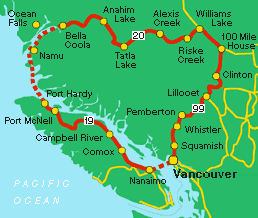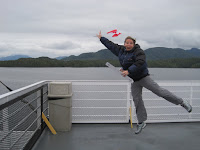
 |
| Our penultimate trip to Garibaldi lake |
But, on the day our friend left, the heavens opened. Eight weeks of pretty consistent rain followed, sometimes heavy, sometimes light, sometimes just showers; but definitely water falling from the sky. Now we're past the 40 day mark, I am wondering whether it might be sensible to commence arc construction...
Anyway, enough whingeing. Without the outdoors not exactly out of bounds, just a bit less fun, what have we been up to?
Good ol' leftie activism
 |
| Neat stickers to put on dollar coins |
Canada has one of, if not the, most incredible and pristine landscapes left in the world. Unfortunately some of it has immense amounts of very dirty, sticky and difficult-to-extract oil in the form of 'tar sands' beneath it. Our next door province, Alberta, fancies itself as the Canadian Texas and wants to sell all its tar sands to China as fast as possible. To get the oil there, they want to construct a pipeline across British Columbia through the 'Great Bear rainforest' to the coast north of Vancouver. Tankers the size of the Empire State Building would then navigate the very complex coastline with several hairpin bends through fjords to collect the oil.
 |
| It did have writing on... |
The experts think a spill is pretty much inevitable, and the environmental and human consequences would be huge (think Exxon Valdez multiplied). So I've been writing lots of letters, attending company sponsored information sessions to ask awkward questions and waving my (not very pro!) homemade placards at one or two rallies. It is heartening to see that the city that gave birth to Vancouver has not yet lots its radical streak. The mainstream media's messaging has swung pretty much 180 degrees and now the pipeline deal looks less and less likely, so here's hoping...
Raising cash
Child poverty is alive and well in British Columbia; one in five under six year olds live in poverty. A national/local charity 'United Way' coordinates a huge fundraising campaign every fall to raise money to prevent child poverty, bullying and social isolation of seniors. It has clear goals and excellent fundraising resources for its corporate partners, including my employer.
 |
| Our coins overwhelmed the machine... |
I used them to helped organise our annual campaign, kicking off with the favourite North American fundraising staple; a 'Pancake Breakfast', then cookie competitions, online auctions and, my favourite, a slightly menacing Superman cut out with our President's face which you had to pay to have removed from your office.
I (hopefully tactfully) encouraged the fundraising committee to become more results focussed and also overhauled the communications to lead with cost examples and case studies. I was pretty chuffed that the number of staff who pledged (either one off or monthly) went up by 35% and we increased our cash intake by 10%. Hopefully a strong platform for next year.
Serving time in the gym
 |
| I'm getting there... |
Never been a big gym goer, preferring life outdoors, but in an effort to finally beat my achilles problems and get strong for skiing, I've hit the gym in a big way. Got myself a programme from a strength and conditioning coach and work on it at least three times per week. Fingers crossed it works and I'll be back running in January and super strong on the slopes.
Waiting for snow
 |
| Tyto the barn owl |
Whistler's had about 10 feet of snow, but the local mountains have had thin pickings... until this weekend. Just back from our first venture up to Grouse Mountain which had a few runs open and got us nicely warmed up. Also got to meet my friend Dan's office mascot.
With most of our friends away for Christmas we'll be house sitting for Mark's boss, taking his slightly nervous dogs for walks, watching 'It's a Wonderful Life' and hopefully hitting the slopes. Have a great holiday season!





































